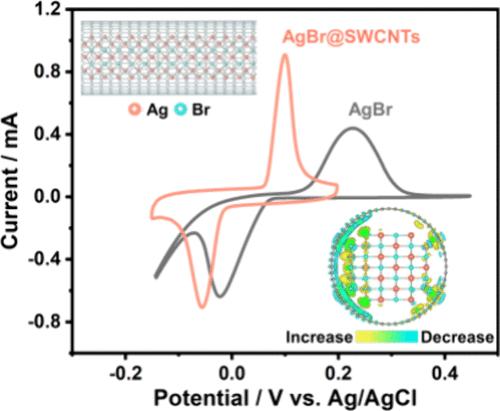Interfacial Charge Transfer in One-Dimensional AgBr Encapsulated inside Single-Walled Carbon Nanotube Heterostructures
IF 15.8
1区 材料科学
Q1 CHEMISTRY, MULTIDISCIPLINARY
引用次数: 0
Abstract
The advent of one-dimensional van der Waals heterostructure (1D vdWH) nanomaterials has provided valuable opportunities for the advancement of electronic or optical devices, as well as for exploring various condensed matter phenomena. Electron transfer is a fundamental process in host–guest interactions, significantly influencing nanoscale physicochemical processes. Elucidating the mechanism by which the host influences the electronic structure of the guest is essential for elucidating these interactions. This study reports the successful synthesis of a material system consisting of precisely resolved AgBr nanowires encapsulated within single-walled carbon nanotubes (SWCNTs) that has been successfully synthesized and utilized to investigate the intrinsic electron transfer across 1D vdWHs. Cyclic voltammetry (CV) was employed to investigate the 1D vdWH interaction between AgBr and SWCNTs, which provided a more intuitive and accurate characterization of the charge transfer from SWCNTs to AgBr. Furthermore, Kelvin probe force microscopy showed a 149 mV reduction in the average surface potential of carbon nanotubes after AgBr filling, supporting the efficacy of CV in probing electron dynamics in 1D vdWHs. Finally, theoretical calculations indicated a charge transfer of 0.11 e– per simulation cell, reinforcing the effectiveness of CV in assessing the interactions within 1D vdWHs.

单壁碳纳米管异质结构中封装的一维 AgBr 的界面电荷转移
一维范德瓦尔斯异质结构(1D vdWH)纳米材料的出现为电子或光学设备的发展以及各种凝聚态物质现象的探索提供了宝贵的机会。电子传递是主客体相互作用的基本过程,对纳米尺度的物理化学过程有重大影响。阐明宿主影响客体电子结构的机制对于阐明这些相互作用至关重要。本研究报告成功合成了一种材料体系,该体系由封装在单壁碳纳米管(SWCNTs)中的精确分辨的 AgBr 纳米线组成。利用循环伏安法(CV)研究了 AgBr 和 SWCNTs 之间的一维 vdWH 相互作用,这为 SWCNTs 到 AgBr 的电荷转移提供了更直观、更准确的表征。此外,开尔文探针力显微镜显示,填充 AgBr 后碳纳米管的平均表面电位降低了 149 mV,这证明了 CV 在探测一维 vdWH 中电子动力学的有效性。最后,理论计算表明每个模拟单元的电荷转移量为 0.11 e-,这进一步证实了 CV 在评估一维 vdWHs 内相互作用方面的有效性。
本文章由计算机程序翻译,如有差异,请以英文原文为准。
求助全文
约1分钟内获得全文
求助全文
来源期刊

ACS Nano
工程技术-材料科学:综合
CiteScore
26.00
自引率
4.10%
发文量
1627
审稿时长
1.7 months
期刊介绍:
ACS Nano, published monthly, serves as an international forum for comprehensive articles on nanoscience and nanotechnology research at the intersections of chemistry, biology, materials science, physics, and engineering. The journal fosters communication among scientists in these communities, facilitating collaboration, new research opportunities, and advancements through discoveries. ACS Nano covers synthesis, assembly, characterization, theory, and simulation of nanostructures, nanobiotechnology, nanofabrication, methods and tools for nanoscience and nanotechnology, and self- and directed-assembly. Alongside original research articles, it offers thorough reviews, perspectives on cutting-edge research, and discussions envisioning the future of nanoscience and nanotechnology.
 求助内容:
求助内容: 应助结果提醒方式:
应助结果提醒方式:


